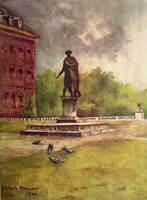The site was occupied by King James's College, founded by Matthew Sutcliffe, Dean of Exeter, in 1610, which, in spite of the King's patronage and the interest of Prince Henry, was a failure. It added to, rather than allayed, religious discussion, and was familiarly known as "Controversy College." The ground was, in 1669, given to the Royal Society, but the buildings were too dilapidated for them to use. To Sir Stephen Fox is probably due the idea of founding a hospital for disabled soldiers, although tradition also attributes some of the credit to Nell Gwynn, who is said to have appealed to Charles II. on their behalf. The King laid the foundation-stone, on the 12th of March 1682, of the building designed by Wren. John Evelyn, as one of the Council of the Royal Society, had been consulted when the idea was first mooted, and in January 1682 he notes in his Diary a talk on the subject with Sir Stephen Fox, who asked for Evelyn's assistance with regard to the staff and management. So in Sir Stephen's study, as Evelyn writes, "We arranged the governor, chaplain, steward, housekeeper, chirurgeon, cook, butler, gardener, porter, and other officers, with their several salaries and entertainments." This list of officials shows the importance of the Garden from the first-and no wonder, as the grounds occupied some twenty-six acres. A survey made in 1702 shows how this space was divided. The largest part, lying to the north of the Hospital, is what is now known as "Burton's Court," and is used as a recreation ground for the soldiers in the barracks near, and a cricket ground for the brigade of Guards. The avenue down the central walk, "planted with limes and chestnuts," was included in the early design, and "Royal Avenue" is a continuation of it, Queen Anne having, it is said, intended to carry it on to Kensington. This part, called "the great court north of the buildings," occupied over thirteen acres. The rest was divided into grass plots between the quadrangle courts and canals, nearly three acres; the "garden on the east, now the governor's," about two acres; a kitchen-garden towards the river of more than three acres, two L-shaped canals with wide walks between, an "apothecary's garden" for medicinal herbs, bleaching yards, and the churchyard. The front garden, with its canals in Dutch style, ended in a terrace along the river. This garden was subject to much abuse by the landscape school of designers. "It was laid out," wrote one in 1805, "when the art of landscape gardening was at its lowest pitch; the principal absurdity in the garden is cutting two insignificant canals as ornaments, whilst one side of the garden is bounded by the noble stream of the Thames." The writer adds that the gardens were open on Sundays in summer, and were much frequented as a public promenade. These severely-criticised canals were filled up in the middle of last century, and the space is now grass with avenues on either side, and a central obelisk, a monument to our soldiers who fell in the battle of Chillianwallah.

